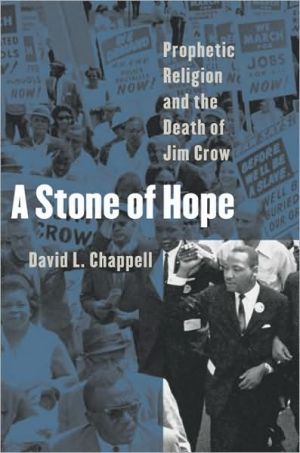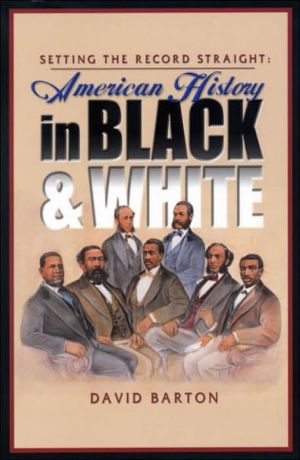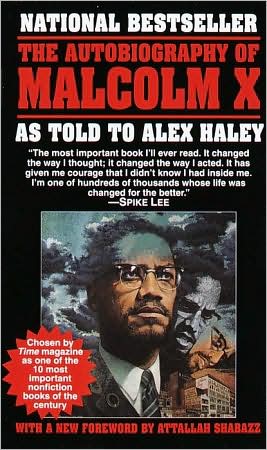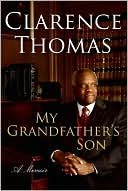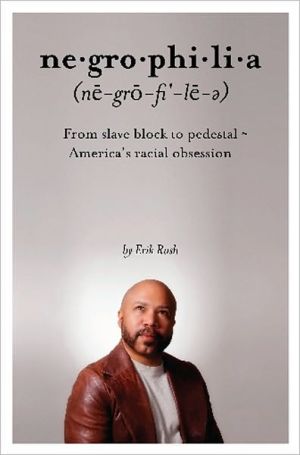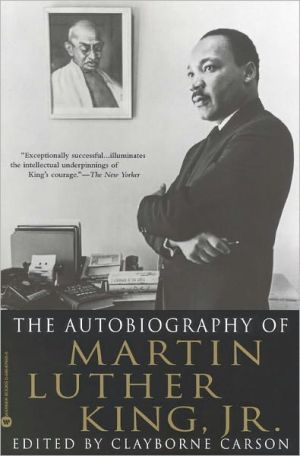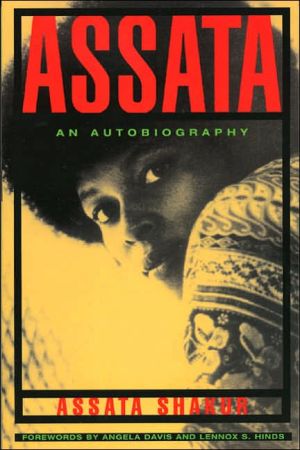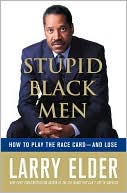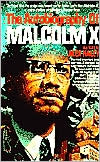A Stone of Hope: Prophetic Religion and the Death of Jim Crow
David Chappell reconsiders the intellectual roots of civil rights reform, showing how northern liberals' faith in the power of human reason to overcome prejudice was at odds with the movement's goal of immediate change. Even when liberals sincerely wanted change, they recognized that they could not necessarily inspire others to unite and fight for it. But the prophetic tradition of the Old Testament - sometimes translated into secular language - drove African American activists to...
Search in google:
In a new assessment of the Civil Rights Movement, Chappell argues that its success was not due to the triumph of liberal ideas after decades of gradual progress, but to the tradition of prophetic religion that brought the vitality of a religious revival to the integrationist cause. Segregationists lost, he says, because they did not have support in their white southern religious denominations.Los Angeles Times Book ReviewA stunning reinterpretation of the American civil rights movement.
A Stone of Hope\ Prophetic Religion and the Death of Jim Crow \ \ By David L. Chappell \ The University of North Carolina\ Copyright © 2003 The University of North Carolina Press\ All right reserved.\ ISBN: 0-8078-2819-X \ \ \ \ Introduction\ In his famous "I Have a Dream" speech at the Lincoln Memorial, Washington, D.C., in 1963, Martin Luther King Jr. said that he was going back to the South with faith that his people could hew "a stone of hope" from "a mountain of despair." That image captures the philosophy of the civil rights movement. The faith that drove black southern protesters to their extraordinary victories in the mid-1960s, this book argues, grew out of a realistic understanding of the typically dim prospects for social justice in this world. Despair was the mountain. Hope was by comparison small, hard to come by. "Freedom isn't free," one of the movement's songs observed: "You gotta pay a price, you gotta sacrifice, for your liberty." In another one of his 1963 speeches King said that the jailed black children of Birmingham were "carving a tunnel of hope through the mountain of despair." \ King's public career had begun in 1955, in a period defined by Joseph McCarthy and Joseph Stalin; by the homogeneity of Levittown and the Man in the Gray Flannel Suit; by a popular president, Dwight D. Eisenhower, who opposed federal action to promote equality; and by equally popular racial demagogues in the southern states. The Democratic Party, in its 1948 platform, and the U.S. Supreme Court, in its 1954 Brown v. Board of Education decision, appeared to repudiate their long-standing support of white supremacy. But neither could do much to change the discriminatory laws and customs in the South. The Democrats retreated from their bold statement, and the Court seemed to consign victims of discrimination to an endless, costly series of individual lawsuits. Many black southerners-including King, for a time-concluded that the rosy promises of change were as false as innumerable promises in the past. Hopes of racial justice seemed as distant as ever.\ Yet over the twelve-odd years of King's career, a mass movement rose up in the South and brought city governments, bus companies, and chambers of commerce to their knees. The movement created disorder so severe as to force a reluctant federal government to intervene-on the side of black southerners, which was more surprising than it seems in hindsight today. The civil rights movement-aided by Democratic-Republican competition for the votes of recent black migrants to the North and by U.S.-Soviet competition for allies among newly independent African and Asian nations-destroyed Jim Crow, the vast system of legal segregation and disfranchisement named after a nineteenth-century minstrel character. In addition to provoking Congress to turn against its powerful southern bloc in the sweeping Civil Rights and Voting Rights Acts of 1964 and 1965, the movement forced a change in the Constitution. The Twenty-fourth Amendment and new interpretations of the Fifteenth guaranteed black Americans the vote. The movement shut down a political culture of racist demagoguery and one-party rule in the southern states, a culture long underwritten by the threat of mob violence.\ The movement did all this with remarkably few casualties. Ugly as white southern resistance was, Maya Lin's memorial to martyrs of the civil rights movement has only 40 names engraved on it. The apartheid regime in South Africa beat that figure in a single day, at Sharpeville in 1960, when it killed 67 people and wounded 200 more. In a freedom struggle closer to our own time, Chinese authorities killed some 2,600 in the immediate aftermath of Tiananmen Square. America's own war to destroy slavery, with 600,000 deaths, makes the destruction of segregation a century later appear astonishingly nonviolent. Its eradication appears a feat of moral and political alchemy, well represented by King's stone of hope from a mountain of despair.\ How did it happen? The civil rights struggle did not consist entirely of politics and grassroots organizing, as books and documentaries on the subject have so far implied. It also involved a change in American culture, a change in what Americans thought and felt when they talked about things like freedom, equality, race, and rights. It involved a change in Americans' expectations about these things, what they considered realistic as opposed to idealistic.\ This book tries to account-and claims only to begin the accounting-for the cultural changes behind the civil rights movement by answering four questions: Why did the dominant voice in American political culture, liberalism, fail to achieve anything substantial for black rights at the height of liberal power in the 1930s? Where did black southerners find a philosophical inspiration to rebel, given the failure of liberalism as they knew it? How did black southerners sustain the confidence, solidarity, and discipline of their rebellion through years of drudgery, setbacks, and risk? Finally, why were the enemies of the civil rights movement, for one fleeting but decisive moment, so weak?\ Chapters 1 through 4 reconsider the intellectual roots of the civil rights movement. The black southern movement's political successes depended on an alliance with northern liberals. Yet the liberals' animating faith was radically different from that of the southern movement. Liberals believed in the power of human reason to overcome "prejudice" and other vestiges of a superstitious, unenlightened past. Liberals believed, with Gunnar Myrdal, the Swedish social scientist whose famous 1944 report on American racism they embraced, that "progress" was under way: further, education, along with economic development, would lead white southerners to abandon their irrational traditions. Therefore liberals, though sincere in their devotion to black rights, did not see any reason to do anything drastic to promote them. Indeed, they thought that pushing too hard for black rights would provoke a violent reaction in the backward white South.\ Liberals' most sensitive and articulate spokesmen, such as John Dewey and Lionel Trilling, were acutely aware of the cultural weakness of their faith in reason. Especially after seeing how difficult it was for the West's liberal democracies to fight the Nazis, liberals envied and feared conservatives' power to draw on irrational wellsprings of myth and tradition. Yet in the South of the 1950s, it was liberals' new black allies, rather than their white supremacist enemies, who drew most effectively on such irrational wellsprings.\ The black movement's nonviolent soldiers were driven not by modern liberal faith in human reason, but by older, seemingly more durable prejudices and superstitions that were rooted in Christian and Jewish myth. Specifically, they drew from a prophetic tradition that runs from David and Isaiah in the Old Testament through Augustine and Martin Luther to Reinhold Niebuhr in the twentieth century. (That tradition also traveled down a different path, via the seventh-century prophet Muhammad, to the mind of the mature Malcolm X and some of his followers, though that path is not examined in this book. The prophetic tradition was not confined to Christianity or even to religion: strictly Christian thinkers like Karl Barth and Reinhold Niebuhr were quick to admit that an atheist might take a prophetic stance more readily and faithfully than a typical twentieth-century Christian.) The thinkers who were active in the black movement-at least the ones for whom I was able to track down an extensive intellectual record-believed that the natural tendency of this world and of human institutions (including churches) is toward corruption. Like the Hebrew Prophets, these thinkers believed that they could not expect that world and those institutions to improve. Nor could they be passive bystanders. They had to stand apart from society and insult it with skepticism about its pretensions to justice and truth. They had to instigate catastrophic changes in the minds of whoever would listen, and they accepted that only a few outcasts might listen. They had to try to force an unwilling world to abandon sin-in this case, "the sin of segregation." The world to them would never know automatic or natural "progress." It would use education only to rationalize its iniquity.\ Like all nonmythical figures, the thinkers of the civil rights movement were inconsistent. They understandably strayed from the Prophets' lonely, undiplomatic, often downright antisocial path. At times they spoke the language of liberal Christianity and secular liberalism, which had in common a very unprophetic faith in human autonomy and self-improvement. They were political strategists, who recognized that the human hopes they needed to cultivate were entwined with consumerist striving for a piece of American prosperity, which was spreading like mad in the post-World War II boom. They were also human: they could forgive consumerist striving in the poor sinners around them and in themselves. The paper trail of more serious moral failings than consumerism on the part of Martin Luther King is now too conspicuous to be ignored. American law dictates a presumption of innocence for the less famous leaders whose trails have not been uncovered. But common sense, not to mention their own prophetic view of human nature, dictates the opposite. The thinkers in the civil rights movement could not live up to their own austere moral vision, could not entirely separate themselves from the world or from the worldview they condemned. That said, they departed from modern liberal faith in the future-from the humanism that had been rising in Western culture, with occasional setbacks, since the Renaissance-far more than historians have recognized. They strayed far more than the allegedly "chastened" liberals of the post-World War II generation, who read Reinhold Niebuhr and claimed to embrace his pessimism about human nature. (In Chapter 1 I argue that liberals only applied that newfound pessimism to foreign affairs, leaving their optimism about life inside the United States, even for the poor and for racial minorities, intact.) The alliance between black Christian civil rights groups and American liberals was more an alliance of convenience than one of deep ideological affinity. Viewed in this light, the alliance's unraveling after the 1960s may not seem as baffling and bewildering as it ordinarily does.\ The movement's few prophetic spokesmen and spokeswomen aside, how can we account for the masses of poor, disfranchised protesters? How did they have the guts and the discipline to stand against the dogs and firehoses when there was no reason to think they would win on this earth? Chapter 5 considers these questions. There is much testimony about conversion experiences during the mass meetings and demonstrations, which no historian or social scientist has put at the center of the story before.\ The conviction that God was on their side comes through in many statements by black movement participants during the 1950s and 1960s. This conviction often came to participants in ritualistic expressions of religious ecstasy. Experiencing and witnessing such expressions gave participants confidence, not simply in the righteousness of their protest, but also in the effectiveness of that protest in this world. Historians have not scrupulously separated the two kinds of confidence, perhaps because they have not entirely forgone their own liberal faith in human progress. To know that one is morally right is easy and common; to believe one is going to defeat one's enemies requires rather extraordinary faith. Being right about the latter matter requires something even more extraordinary than faith.\ Perhaps the hardest and greatest hope of the civil rights protesters was hewn from that impassible, snow-capped range of bigotry, hypocrisy, and social conservatism, the southern white church. That is the subject of Chapters 6 and 7. Though the white churches of the South drew indignant criticism from black and northern white ministers for their failure to fall into line behind the black protesters-criticism that historians have echoed-what was surprising was that those churches did not lend much support to the other side. White southern churches, though they were then celebrating the centennial of the Civil War, did not follow the example of their antebellum ancestors. A hundred years earlier, ministers and theologians had led the pro-slavery cause with brilliance and vigor. (It is hard to account for the suicidal devotion of nonslaveowning white southern families-three-fourths of the South's white population-to the slave system without the faith they learned to have in the moral superiority of slavery. Their ministers and theologians taught them to see slavery as a benevolent bulwark against the North's anarchical and irresponsible "freedom," which let workers go homeless and starve.)[1] More recently, southern white churches had worked aggressively and creatively to instill industrial discipline (sobriety, obedience to authority, and individualist disdain for labor unions) during the great social struggle over industrialization of the Carolina Piedmont.[2] And, not so long after the civil rights battles, southern churches mobilized masses in the antiabortion movement and other political feuds over "family values."\ But unlike white southern social conservatives before and after them, the segregationists in the 1950s-60s tended to identify their own white southern churches as their enemy. Most readers today are surprised to learn that the southern Baptists and southern Presbyterians went on record in favor of desegregation in the mid-1950s by a majority vote of representatives of their member churches. In the Southern Baptist Convention (SBC), the vote was roughly 9,000 to 50 in favor of desegregation; in the General Assembly of the southern Presbyterians, it was 239 to 169.[3] These figures are more striking in light of the near-unanimity of elected officials against desegregation.\ It is important to remember that the southern Baptists and southern Presbyterians in the 1950s@-60s were still maintaining the separate denominations their forebears had created when they broke from their northern counterparts over slavery: segregationists could not blame the desegregationism of their denominational assemblies on Yankee control. White churches at the local level were less unified than the regionwide denominational bodies. The vocal opposition of lay segregationists and, in rare instances, politicized clergy, made the issue so controversial that most ministers seem to have tried to avoid it. The most important consequence of this was that segregationist propaganda often condemned the southern white clergy en bloc for its failure to stand up for the white South's cause.\ \ Continues...\ \ \ \ Excerpted from A Stone of Hope by David L. Chappell Copyright © 2003 by The University of North Carolina Press. Excerpted by permission.\ All rights reserved. No part of this excerpt may be reproduced or reprinted without permission in writing from the publisher.\ Excerpts are provided by Dial-A-Book Inc. solely for the personal use of visitors to this web site. \ \
Introduction11Hungry Liberals: Their Sense That Something Was Missing92Recovering Optimists263The Prophetic Ideas That Made Civil Rights Move444Prophetic Christian Realism and the 1960s Generation675The Civil Rights Movement as a Religious Revival876Broken Churches, Broken Race: White Southern Religious Leadership and the Decline of White Supremacy1057Pulpit versus Pew1318Segregationist Thought in Crisis: What the Movement Was Up Against153Conclusions: Gamaliel, Caesar, and Us179AppA Philosophical Note on Historical Explanation191Notes195Archival and Manuscript Sources293Bibliographical Essay297Acknowledgments327Index331
\ From the Publisher"[A] pathbreaking study of prophetic Protestantism and the camapaign against Jim Crow."\ — Commonwealth\ \ \ \ \ The Washington PostA Stone of Hope is a richly provocative book if only for its valuable discussion of segregationists' surprisingly speedy defeat. — David J. Garrow\ \ \ Atlantic MonthlyOne of the three or four most important books on the Civil Rights movement. . . . Chappell argues persuasively that revivalism engendered the Civil Rights movement's solidarity, leadership, worldview, and rhetoric . . . and that the struggle against segregation triumphed owing not only to the religious views of southern blacks, but also to the religious views of southern whites.\ \ \ \ \ Los Angeles Times Book ReviewA stunning reinterpretation of the American civil rights movement.\ \ \ \ \ Publishers WeeklyIn 1963, Martin Luther King Jr. famously said that the South could hew "a stone of hope" from segregation's "mountain of despair." This book explores the role that religion played in shaping that hope. In a brilliant chapter on the grassroots character of the civil rights cause, Chappell argues that the movement could be considered less a political protest with religious dimensions than a religious revival with political and social dimensions. The civil rights struggle had many of the elements of revival-miracle stories, mass religious enthusiasm, music, "conversion" experiences, even messianic expectations. Chappell writes engagingly, drawing an important revisionist portrait of the crucial role of religion in defeating Jim Crow. (Jan. 26) Copyright 2003 Reed Business Information.\ \ \ \ \ Library JournalThe Civil Rights Movement had a profound impact on American society, causing the collapse of the system of legalized segregation and disenfranchisement of blacks in the Southern states. Chappell (history, Univ. of Arkansas) explores the dynamics that allowed the movement to succeed and to do so, in contrast to the Civil War, with amazingly little death and violence. At the center of the movement was a religious tradition inspired by the Hebrew prophets and informed by the realism of Reinhold Niebuhr. This was a tradition that had the power to move people to commitment, sacrifice, and self-discipline, power that liberal optimism lacked, even as segregationists' rhetoric imploded. Chappell's meticulously researched yet engaging narrative gives the religious aspects of the movement their well-deserved due. At the same time, he places the account in a richly textured tapestry of American culture and intellectual life. This nuanced, compellingly argued book makes sense of the contingent factors that conspired to bring the movement success and explains why it is so difficult to marshal those dynamics for further social change. It belongs in every library.-Steve Young, McHenry Cty. Coll., Crystal Lake, IL Copyright 2003 Reed Business Information.\ \
